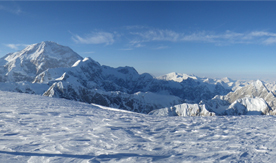Glacier’s Past Offers Clues to the Future

Editor’s note: A narrated slideshow about the collaborative research by UMaine, Dartmouth and the University of New Hampshire is online.
University of Maine climate change scientist Karl Kreutz seeks to glean insight into future sea level rise on the planet.
To do that, this past spring he was part of a research team that hiked a 14,000-foot mountain in Alaska, drilled through a glacier and collected two 700-foot, 3-inch-diameter ice cores encasing 1,000 years of regional climate history.
“The Arctic is warming rapidly and Alaskan glaciers are shrinking as a result,” says Kreutz. “If we have a better understanding of the snowfall and climate change the last 1,000 years, we can better predict what will happen to glaciers in Alaska in the future as global warming continues, and how that will impact global sea level rise.”
UMaine is collaborating with Dartmouth University and the University of New Hampshire in the ice core-drilling project in Alaska’s Denali National Park. The multiyear endeavor is funded with a $1.1 million grant from the National Science Foundation (NSF).
In addition to Kreutz, UMaine participants are Research Assistant Professor Sean Birkel and graduate students Seth Campbell and Tim Godaire. UMaine graduate Erich Osterberg, now an assistant professor at Dartmouth, as well as University of New Hampshire scientist Cameron Wake and graduate student Elizabeth Burakowski, Dartmouth students, the National Park Service and the U.S. Ice Drilling Program Office are also participating.
“These ice cores will provide our first long-term annual record of snowfall in this region,” says Wake, a research associate professor at the UNH Institute for the Study of Earth, Oceans, and Space Earth Systems Research Center (ESRC).
The field season started at the beginning of May, when team members climbed and skied 14,000 feet up then down Denali to acclimate to the altitude. Daytime temperatures were around 32 F and nighttime temps dropped to about 13 below zero F during the excursion, says Kreutz.
A helicopter operator delivered the team’s equipment and supplies to the drill site on Mount Hunter. The National Park Service requested that power for the drilling be supplied by renewable power — in this case, a combination of solar and wind.
Kreutz says the team drilled right to the bedrock. “You know you’ve got the longest climate record from the glacier at that point,” he says. “When you hold a piece of 1,000-year-old ice, it’s hard not to think about world history and what was happening when that ice was being formed.”
Kreutz credits Campbell, a doctoral student in glaciology, for selecting the prime drilling spot on the plateau. Campbell used ground-penetrating radar to map the geometry of glaciers and determine the velocity at which they’re moving in order to select a site where layers inside the glacier were as flat as possible.
Like tree rings, ice cores can provide data from their annual layers. Studies of the ice cores will concentrate on the chemistry of the ice — how much dust is in it, how much sea salt is in it — and determine the relative amounts of chemical elements, including pollutants.
In mid-June, the ice cores, drilling personnel and equipment were transported from Mount Hunter via helicopter to base camp and then on a ski plane to Talkeetna, Alaska. The cores were then packed in freezer trucks and hauled to the National Ice Core Laboratory in Denver, Colo., where they are in frozen storage.
This fall, Kreutz and other participating scientists will travel to the lab in Colorado where they’ll cut the ice cores into square sticks, which will then be transported to the respective university labs.
During the next couple of years, scientists at UMaine, UNH and Dartmouth will melt the ice and analyze thousands of samples using mass spectrometers, ion chromatographs and other instruments. Researchers will interpret the data using statistical analyses. They’ll compare the data with other records, incorporate it into glacier and climate models and share it with the broader paleoclimate and scientific community.
Collaborators have been working on the project for six years. The team is maintaining a weather station in Denali National Park, with the goal of relating the weather in the mountains to the snow chemistry.
— Beth Staples, 207.581.3777
